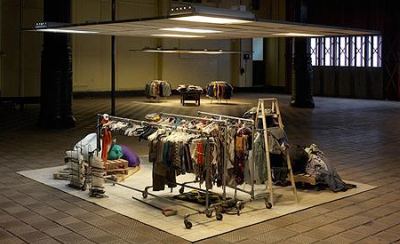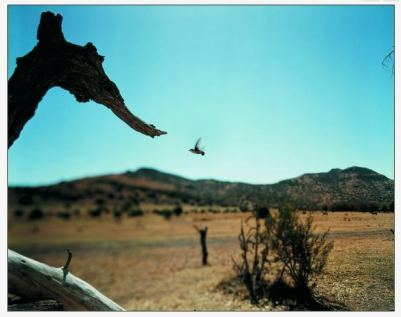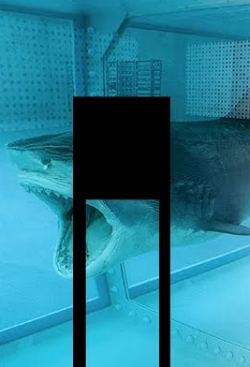Eva Lake on becoming an artist:
An artist was all I wanted to be; it was the obsession. A Working Woman
in New York City, I instead maintained a wannabe status, if only in my
mind. Help and time was the ultimate Nirvana. My boyfriend told me that
any help came with strings attached and the whole thing was impossible
anyway. He said he had given up the game and didn’t even want to go to
openings, which was sort of odd because that was where we met. My
response at the time was that my job at Bergdorf Goodman had all kinds
of strings attached anyway – I can dream, can’t I? (more)
About the much-commented rantings of Glenn Beck as art critic: Christopher Knight offered the best reality check rebuttal (here), but Lee Rosenbaum (Culture Grrl) was tops on a bigger issue, one on which Beck is right. We don’t want the NEA to become the National Endowment for Good Works. Culture Grrl below:
The Beck clip that deserves notice (below, via) addresses the Obama administration’s attempt to rally the art brigades
around its social-service agenda. Particularly noteworthy is the audio
recording played about six minutes into the clip—the voice of Yosi Sergant,
director communications for the National Endowment for the Arts, saying
the following to the members of the arts community who participated in
the White House’s United We Serve conference call on Aug. 10:
Bear
with us as we learn the language so that we can speak to each other
safely. And we can really work together to move the needle to get stuff
done. (more)
Rosenbaum’s update here.
Richard Dorment Charles LeDray in London:

The enormous prestige accorded to American artist Charles LeDray over the years is closely correlated to the strangeness of his working methods and the rarity of his work. LeDray did not train as a fine artist. A former museum security guard, he’s a self-taught craftsman whose work looks like no one else’s I can think of. Mens Suits, sponsored by Artangel and shown in a disused Edwardian fire station in the depths of Marylebone, west London, is his first show in this country. When you see it, you will instantly understand why it took him three years of full-time work to make it. (more)
Richard B. Woodward makes a good case against Jean Luc Mylayne, an artist I continue to admire:

For an artist whose work is devoted to enlarging our sense of ourselves within nature, he seems rigidly focused on his own experience. Even his attention to unshowy species seems confined to showcasing them against rural backdrops. If nature in all of its humbling variety is his subject, where are his photographs investigating our urban relationship to gulls and pigeons?
…Just because an artist gets high on his own inflated oratory is no reason a curator has to participate in a folie à deux. The museum here neither serves a public skeptical about the opacity of contemporary art nor does Mr. Mylayne any favors by framing his modest, if persistent, achievement under crushing layers of grandiloquent hokum. ( more. In contrast, my review of an an exhibit last year here.)
Brent Burket on the Met’s inability to exhibit Damien Hirst, titled, The Aesthetic Possibility of Killing Something When It’s Already Dead:

What is it about Damien Hirst’s The Physical Impossibility of Death in
the Mind of Someone Living that makes the staff at the Met–a seemingly
intelligent group of people–so blindingly stupid? Is the formaldehyde
leaking? Are all the thoughts about the physical impossibility of death
snapping their synapses like gift shop cinnamon sticks?(more)
Jen Graves on a Paul McCarthy and Richard Jackson interview at the Seattle Art Museum. She’s killer good on setting up background and atmosphere, but what did they say? Did they rise above the shallow wisecracks listed here?
McCarthy is an art hero; he sort of took the soul out of Conceptualism
and put it in a deeply messy and yet Hollywooded body, and he’s been
written about and emulated for years. In person he comes across as a
regal dwarf. It’s not that he’s that short; he’s just shaped
dwarfishly. And it is impossible not to notice that his hands are so
thick that they are obscene. (“They’re penises on palms,” someone said
to me. “How were they when you shook them? Succulent?” They were. They
were succulent. Yes, it is all magnificently disturbing. This is the
guy who, wearing women’s clothes, humped raw hamburger and ketchup in a
1975 performance.)
(more)
Mark Hudson on Zhang Huan: (Below, Zhang Huan’s My America at the Seattle Art Museum in 1999, a performance that featured a wide array of Seattle writers, artists, collectors, curators, an art book editor (Joseph Newland) no critics and one art dealer, the late Linda Farris, who was the ultimate game girl.) To judge from Hudson’s piece, Zhang might be better known in the States than in London.

You may not have heard of Zhang Huan, but he appears poised to be the first
non-Western artist to become a truly global name — on a par with Damien
Hirst, Jeff Koons or even Andy Warhol. And the central element in an oeuvre
encompassing painting, performance, installation and sculpture is his own
extraordinary physical presence: the shaven head and stoic, monk-like
features that have appeared in everything from wince-makingly uncomfortable
performances to vast sculptures, such as Three Legged Buddha which filled
the Royal Academy‘s forecourt in 2007.
(more)
Kenneth Baker on Jenny Bloomfield and Jennie Ottinger: The S.F. Chronicle’s art critic doesn’t write a lot and can be disengaged and/or cranky, but when he’s on, he’s one of the best in the newspaper realm:
Even a generation ago, abstract painters might still view their
discipline as an arena of struggle. Struggle with the inertia of
materials, struggle for authentic expression within the tainted matrix
of pop culture, struggle for originality with so many possibilities
exhausted.Today, on the downslope of postmodernism, such ambitions seem more self-dramatizing than responsive to the realities.
British-born Bay Area painter Jenny Bloomfield stands out against
this dispiriting background, making abstraction look alive again
without nostalgia, triviality or bombast. Those who think this sounds
easy ought to give it a try. (more)
Finally, offered as a small, charming note, Maira Kalman explains through drawings the history of life on Earth: Evolution to Irving Berlin.



Leave a Reply